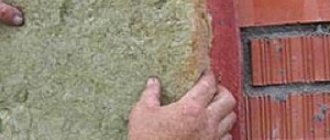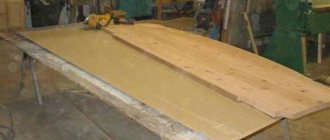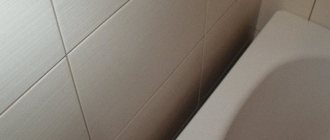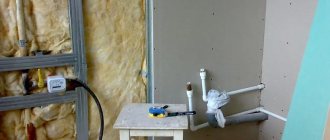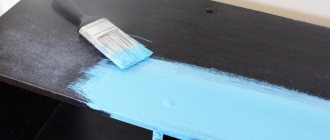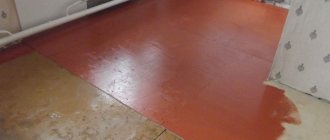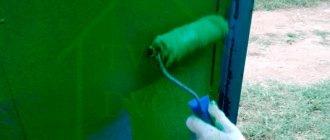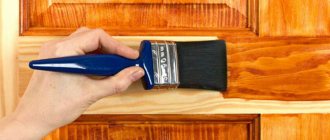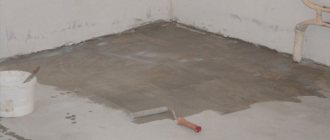Rating 3.75 (18 Votes)
Aluminum, like some other non-ferrous metals, is quite difficult to paint well at home. The fact is that aluminum quickly oxidizes when interacting with ordinary air, and a coating forms on its surface, which practically does not interact in any way with traditional paints and varnishes - primer, paint, varnish. This means that if you do not follow the instructions for painting aluminum, the fresh paint will not last long and your aluminum product will need to be repainted. Typically, aluminum parts and products are painted under special conditions, using specialized equipment, and the process of anodizing precedes the painting of aluminum.
Anodizing is a process of chemical or electrochemical treatment of the surface of aluminum (or other non-ferrous metals) to prevent surface oxidation. Anodized aluminum can be easily painted in any color, because... The anodized surface has excellent adhesion (adhesion) to paint or primer.
So how and with what to paint aluminum with your own hands at home?
We offer you two options for painting aluminum:
1 With anodizing and aniline dye 2 Without anodizing, using a special primer and special zinc-aluminum metal paint
Of course, you will get the highest quality and durable result only after anodizing, but this is not easy to do at home, especially if you are painting something large - car rims, an aluminum boat, etc., so you can resort to a simpler option - preparing aluminum for painting with a primer “for aluminum, stainless steel and galvanized surfaces.”
General information about anodizing technology
Aluminum anodizing technology is similar to galvanic processing. The deposition of solution oxide ions on the workpiece occurs in a liquid electrolyte at high or low temperatures. The use of a heated solution is possible in industrial installations, where it is possible to carefully control and regulate voltage and current in automatic mode.
At home, they usually use the cold method. This method is quite simple, does not require constant monitoring, and the equipment and consumables are available. To prepare the solution, you can use the electrolyte used in lead car batteries. It is sold in every auto store.
The high strength of the protective oxide film depends on its thickness, which is obtained at home by processing in a cold solution. The increase is made by stepwise regulation of the operating current.
Result of anodizing aluminum
Black anodized aluminum
Oxidizing aluminum black is referred to as color anodizing. Black color is obtained in two stages. First, a colorless film is applied electrolytically, and then the workpiece is placed in a saline solution of acids. Depending on the acid, the color can range from pale brass to deep black. Black aluminum is widely used in construction and decoration.
3 Flute End Mills:
3 flute end mills are the best choice for carbide end mills 98% of the time. Chip clearance is the name of the game when working with aluminum, and the 3 flutes provide the perfect balance of tool strength and chip clearance.
2 flutes may be an acceptable option when cutting forces are lower and chip clearance is a more important factor. This can also be a way to reduce cutting force for light, poor quality cuts. This makes sense if you have a very long tool that is prone to vibration. 2-flute cutters cut easily, so this can help with vibration.
However, at the end of the day, 3 grooves are the industry standard. For larger tools, such as cap cutters, the optimal number of flutes depends on the diameter. The main thing here is to have a large gap for the chips so that nothing gets clogged. Nobody wants a jammed tool at 700 IPM.
Preparatory process
To obtain a smooth surface, the workpiece must be polished at the preparation stage. Using a felt or other polishing wheel, scratches are removed and large pores are tightened. The absence of micro-irregularities reduces the likelihood of burnouts. The anodic film is not able to hide external defects.
Before anodizing aluminum, it is necessary to determine the dimensions of the parts to be processed. The resulting layer is 50 microns thick, so it will be impossible to screw a nut onto the treated thread. If the parts are connected using a fit, then do not forget that after anodizing the parts cannot be ground.
Carrying out anodizing at home
To carry out the process, containers are needed. Containers for anodizing must correspond to the dimensions of the parts, and be slightly larger. Therefore, they usually use several baths. The material of the containers is aluminum. But if the products are small, then plastic containers are suitable. Only aluminum sheets need to be laid on the bottom and along the walls. This is necessary to create a current of uniform density throughout the entire volume.
The electrolyte needs to be insulated from external heat. When heating it will have to be changed. To prevent heating, the outside of the container is covered with a layer of thermal insulation. It can be covered with polystyrene foam up to 50 mm thick or, placed in a box, the free space can be filled with polyurethane foam.
A sulfuric acid solution is prepared by diluting the electrolyte for car batteries with distilled water in proportions of one to one. By purchasing a canister with a capacity of 5 liters, you can get 10 liters of solution.
Mixing, when water is added to the acid, is accompanied by abundant heat, and it literally boils and splashes. Therefore, for safety reasons, sulfuric acid is poured into a container of water.
Before anodizing aluminum begins, it is subjected to chemical preparation. Chemical preparation is a degreasing process. In industrial conditions, treatment is carried out with caustic soda or potassium. But at home it is better to use laundry soap. A toothbrush and soap solution can easily remove dirt from the surface. After that, the workpieces are first washed with warm water, and then with cold water.
An alternative to laundry soap is washing powder. After dissolving it in a closed plastic container and placing the parts to be processed there, shake vigorously. Then the parts are washed and dried with a stream of hot air. The active oxygen contained in the washing powder protects fat-free products, even if handled with bare hands.
Electrolyte preparation
Acid solutions are considered unsafe reagents, so to anodize aluminum at home, they resort to a different type of solution. To prepare it, use salt and soda, which you always have on hand.
To prepare the electrolyte, take two plastic containers. They are filled with salt and soda compositions, observing the proportion: per serving of salt or soda 9 servings of distilled water.
Anodizing at home
After dissolving the components, the solution is kept to allow undissolved particles to settle to the bottom. When pouring into a container for anodizing, it must be strained.
Choice of product
The disadvantages of aluminum include the softness of the metal and its instability to abrasive influences. If you plan to keep your pans shiny for longer, avoid using wire wool, brushes, abrasive sponges, or sandpaper.
Even the use of a melamine sponge, which can rid the metal of the oxidation film, will affect the appearance of the utensils - the shiny surface will become dull due to numerous micro-scratches.
Polishing with GOI paste will help return it to ideal condition - rub a rag soaked in a solvent with a piece of hard paste, and then polish the metal surface to a mirror shine.
When choosing how to clean aluminum, you should pay attention to substances that are almost always at hand for any housewife. These include:
- laundry soap;
- baking soda;
- salt;
- table vinegar;
- lemon juice or citric acid;
- dairy products;
- cream of tartar;
- office glue;
- oxalic acid, etc.
Aluminum anodizing methods
Several methods have been developed for processing aluminum alloys, but the chemical method in an electrolyte environment has found widespread use. Acids are used to obtain a solution:
- sulfur;
- chrome;
- oxaline;
- sulfosalicylic acid.
To impart additional properties, salts or organic acids are added to the solution. At home, sulfuric acid is mainly used, but when processing parts with complex configurations, it is preferable to use chromic acid.
The process occurs at temperatures from 0°C to 50°C. At low temperatures, a hard coating forms on the surface of aluminum. As the temperature rises, the process proceeds much faster, but the coating is highly soft and porous.
Aluminum hard anodizing technology
In addition to the chemical method, in some cases the following methods of aluminum anodization are used:
- microarc;
- color:
- adsorption;
- immersion in electrolyte;
- dipping into a dye solution;
- electroplating;
- interference;
- integral.
Rules for using aluminum cookware
Every housewife can preserve the original appearance of kitchen utensils, protect them from deformation and serious contamination. To do this, follow the basic recommendations for the operation and care of aluminum products:
- Do not use dishes for pickling cucumbers, cabbage and other products. The acid reacts with the metal, which provokes the release of toxic substances that are hazardous to health.
- Aluminum utensils are not suitable for daily use due to rapid wear.
- Do not store leftover food in aluminum containers.
- Avoid prolonged exposure of metal to high temperatures. Use medium to low heat while cooking.
- For cleaning, do not use powder, sandpaper, or other abrasive tools.
Proper operation and proper care will help maintain the cleanliness and shine of aluminum products
Aluminum products are lightweight, multifunctional, and easy to use. With proper use and care, a kitchen utensil, sink or part will last a long time, fulfilling its main purpose.
Warm anodizing
The warm anodizing method is used to obtain a base for painting. The coating is porous, but due to this it has high adhesion. Epoxy paint applied on top will reliably protect the aluminum from external influences.
The disadvantage is the low mechanical strength and corrosion resistance of the coating. It is destroyed upon contact with sea water and active metals. This method can be done at home.
The process takes place at room temperature or higher (no more than 50°C). After degreasing, the workpieces are mounted on a suspension that holds them in an electrolyte solution.
Anodizing continues until a milky coating appears on the surface. After removing the stress, the workpieces are washed in cold water. The parts are then painted. They are dyed by placing them in a container of hot dye. After that, the obtained result is consolidated for 1 hour.
Methods for color anodizing of aluminum
Cutting tool material:
Carbide cutting tool. Even in non-manufacturing applications, carbide is superior to high-speed steel in both tool life cost and surface finish. However, there are a few useful things to know about carbide that will help you find the perfect tool for the job. Basically, we just need to understand what we want to get from the tool. Aluminum cuts softly, that is, the tool does not experience strong shock loads when cutting. Maintaining a sharp edge is critical. For this reason, we will prefer hardness rather than toughness to characterize the material. There are two main things that affect this property: the carbide grain size and the binder ratio.
Cold technology
To anodize aluminum you need:
- power supply 12 V (battery, stabilizer);
- aluminum wires;
- rheostat;
- ammeter;
- containers for solutions.
Cold technology is different in that the growth of the anodized coating on the metal side proceeds at a faster rate than its dissolution on the outside.
First, the preparatory work described above is carried out. Then the parts need to be secured. It should not be forgotten that a film does not form under the fastening element. And suspended workpieces, when lowered into the container, should not touch the walls and bottom.
The anode is connected to the parts from the power source, and the cathode is connected to the capacitance. The current density is selected within the range of 1.6-4 A/dm2. Recommended values 2-2.2 A/dm2. At small values, the process will proceed more slowly, and at large values, a breakdown of the circuit may occur and the coating will begin to collapse.
It is not recommended that the electrolyte temperature rise above 5°C. When anodizing, the electrolyte does not heat up evenly. It is warmer in the center than in the corners of the container, so constant stirring is necessary.
The duration of anodizing using the cold method is about half an hour for small elements. For large parts, the duration may be 60-90 minutes. The end of the process is indicated by a changed color on the surface of the aluminum product. After disconnecting the wires, the part is washed.


